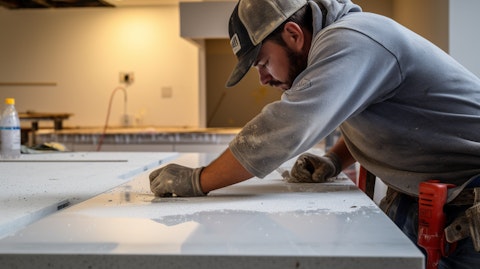Caesarstone Ltd. (NASDAQ:CSTE) Q1 2025 Earnings Call Transcript May 10, 2025
Operator: Greetings, and welcome to the Caesarstone First Quarter 2025 Earnings Conference Call. [Operator Instructions] As a reminder, this conference is being recorded. It is now my pleasure to introduce your host, Brad Cray of ICR. Thank you. You may begin.
Brad Cray: Thank you, operator. And good morning to everyone on the line. I am joined by Yos Shiran, Caesarstone’s Chief Executive Officer; and Nahum Trost, Caesarstone’s Chief Financial Officer. Certain statements in today’s conference call and responses to various questions may constitute forward-looking statements. We caution you that such statements reflect only the company’s current expectations and that actual events or results may differ materially. For more information, please refer to the risk factors contained in the company’s most recent annual report on Form 20-F and subsequent filings with the SEC. In addition, on this call, the company will make reference to certain non-GAAP financial measures, including adjusted net loss income, adjusted net loss income per share, adjusted gross profit, adjusted EBITDA and constant currency.
A reconciliation of these non-GAAP measures to the most directly comparable GAAP measures can be found in the company’s first quarter 2025 earnings release, which is posted on the company’s Investor Relations website. On today’s call, Yos will discuss our business activity and Nahum will then cover additional details regarding financial results before we open the call for questions. Thank you. And I would now like to turn the call over to Yos. Please go ahead.
Yos Shiran: Thank you, Brad, and good morning, everyone. Thank you for joining us to discuss our first quarter 2025 results. Our first quarter performance demonstrates continued stabilization in our business. Despite ongoing global economic headwinds that have weighted on our activities across most channels and pressured our year-over-year comparisons, the modest sequential improvement in revenues and adjusted EBITDA is encouraging and underscores the strength of our strategic direction. Our transformation is fundamentally reshaping our operations. We have created operational flexibility by shifting more than 70% of our production to our global manufacturing network. This allows us to adapt quickly to market fluctuations and has been instrumental in maintaining resilient gross margins amidst revenue headwinds.
Our ongoing investments in porcelain reinforce our confidence in its future growth as a strategic pillar of our business. Having exercised our call option, we expect to complete the Lioli Ceramica minority acquisition this quarter. Full ownership will empower us to drive innovation and capture new opportunities across our porcelain portfolio. In Australia, we have made significant progress with our zero crystalline silica products. The majority of these products are already available in the market with additional offerings on track to launch in the coming months. This comprehensive collection not only ensures compliance with regulatory requirements, but strengthens our competitive positioning in this important market. The recently announced U.S. tariff on imports presents a new challenge that we are actively addressing.
With approximately half of our revenues generated in the U.S., we are engaging with our manufacturing partners to optimize our supply chain, while evaluating strategic pricing adjustments to protect margins. Despite these challenges, our balance sheet is strong with a net cash position of $85.3 million. This provides us with a significant financial flexibility to navigate the current environment while continuing to invest in our business priorities. Our pivot from an industrial-oriented organization to one centered on R&D, marketing and brand development continues to progress as planned. The structural improvements we are making to our business model are designed to strengthen our competitive position and enable us to achieve higher levels of profitability when market dynamics improve.
I will now turn the call over to Nahum to review our financial results in more detail.

Nahum Trost: Thank you, Yos. And good morning, everyone. Looking at our first quarter results, global revenue was $99.6 million compared to $118.3 million in the prior year quarter. On a constant currency basis, first quarter revenue was down 14.5% year-over-year due to lower volumes across our main regions, resulting from continued global economic headwinds affecting activity across all channels in addition to competitive pressures. In the U.S., sales were down 19.4% to $49.1 million, primarily reflecting softer market conditions in the residential channel, including the business through Caesarstone suppliers. We also saw softness in the Commercial segment. Our big box business performed relatively better compared to the prior year quarter.
Canada sales were down 11.5% on a constant currency basis, driven by lower sales in our core business, partially offset by solid growth in our large retail channel. Australia sales were off by approximately 28.2% on a constant currency basis, mainly reflecting market uncertainty following the governmental ban on silica-based engineered stone products and slower market conditions due to high interest rates and fewer new home completions. Our EMEA region was a bright spot with an increase of 16.4% on a constant currency basis. We saw growth in EMEA distributor channel, reflecting improved market conditions and favorable timing of orders. In Israel, sales increased by 13.2% on a constant currency basis, in line with our expectations given improving market conditions as the impact of the war on terror begins to normalize.
Looking at our first quarter P&L performance. Gross margin in the first quarter was 21.3% compared to 24.5% in the prior year quarter. The decrease in gross margin was mainly due to lower fixed cost absorption due to reduced volumes and unfavorable product mix. These factors were partially offset by the ongoing benefits of our improved production footprint and reduced exposure to high cost inventory following the Richmond Hill plant closure, along with the realization of other savings from our restructuring actions. Operating expenses in the first quarter were $35.9 million or 36.1% of revenue compared to $34.6 million or 29.2% of revenue in the prior year quarter. Excluding legal settlements and loss contingencies, operating expenses were $32.5 million or 32.6% of revenue compared to $33.9 million or 28.6% in the prior year quarter.
In absolute terms, the difference reflects our cost optimization efforts, while the increased percentage primarily reflects the impact of lower revenues against our relatively fixed cost base. Adjusted EBITDA in the first quarter was a loss of $7.1 million compared to a gain of $0.6 million in the prior year quarter. The year-over-year reduction in adjusted EBITDA primarily reflects lower revenues and gross margin. Adjusted diluted net loss per share for the first quarter was $0.29 on 34.6 million shares compared to adjusted diluted net loss per share of $0.13 in the prior year quarter on a similar share count. Turning to our cash flow and balance sheet. We ended the quarter with a solid financial position. As of March 31, 2025, our balance sheet included total cash of $88.8 million and total debt to financial institutions was $3.5 million.
We have made significant progress in subleasing the majority of available land and buildings at our Sdot Yam facility, which we expect will generate cash savings of approximately $3 million during 2025. We used cash for operating activities in the amount of $15.1 million during the first quarter, primarily reflecting seasonal working capital patterns and some inventory build. Despite this usage, our overall balance sheet strength provides us with significant financial flexibility to continue executing our strategic initiatives. Before turning to our outlook, I’d like to comment on a few matters. Regarding the U.S. tariffs announced in April, we are actively assessing the potential impact. The 10% tariff on imported goods from multiple countries, including Israel, affects our U.S. business, which represents approximately half of our total revenues.
We are in regular dialogue with our manufacturing partners to optimize our supply chain and are evaluating pricing actions in the U.S. to balance market competitiveness with margin protection. As of March 31, 2025, we were subject to lawsuits involving 357 injured persons alleging injuries associated with exposure to respirable crystalline silica dust. These cases are spread across Israel, Australia and the United States. We have recorded a provision of $50 million, representing our assessment of the probable and estimable exposure with insurance receivable for silicosis-related claims totaling to $31.6 million. The $50 million provision also includes the provision for two U.S. cases for which loss is probable and estimable under U.S. GAAP.
We estimate the loss for 18 of the remaining 174 U.S. cases is only reasonably possible with a range between $0.5 million to $13 million per claim. The other claims are at an early stage in which the amount of the possible loss cannot be reasonably estimated at this time, given the preliminary stages, complexity of the claims and the uncertainty as to our liability and the scope of insurance coverage. Now turning to our outlook for 2025, given the persistent macroeconomic pressures across our global footprint and the recently imposed U.S. tariffs, we are withdrawing our full year outlook as we assess the potential direct and indirect impacts on our results. Even so, we remain focused on disciplined execution of our transformation, and we have a fortified balance sheet.
We are on track to realize the full benefits of our cost optimization initiatives of approximately $10 million in incremental savings in 2025 compared to the full year of 2024. These savings reflect the successful execution of our plant closures and manufacturing optimization. In closing, despite the headwinds we face, we remain confident in our ability to execute our transformation. The implementation of our strategy has positioned us well to manage near-term headwinds, while preparing for improved performance as market conditions normalize. With that, we are now ready to open the call for questions.
Q&A Session
Follow Caesarstone Ltd. (NASDAQ:CSTE)
Follow Caesarstone Ltd. (NASDAQ:CSTE)
Receive real-time insider trading and news alerts
Operator: We will now begin the question-and-answer session. [Operator Instructions] Our first question comes from Reuben Garner with Benchmark. Please go ahead.
Reuben Garner: Thank you. Good evening guys.
Yos Shiran: Good morning.
Nahum Trost: Good morning.
Reuben Garner: So, I guess to start, a nice sequential improvement in margins from Q4 to Q1 on a similar top line. Can you walk through – it looks like maybe almost a couple of hundred basis points on the gross margin side of improvement. How much of that was some of your savings flowing through and what other factors maybe led to the improvement?
Nahum Trost: Hi Reuben, this is Nahum. Yes. So, as you said, we saw some improvement in the gross margin. Some of it relates to the modest increase also in terms of revenues; and the other part related to our restructuring actions that we took in the past; and some of it – we are already benefiting from some of it in Q1. So those are the main things that helped to improve the gross margin from Q4. Compared to Q1, there is a decline. Some of it relates to the lower volume. Also, the FX had a relatively significant negative impact on us as the U.S. dollar got stronger against the Australian dollar and the Canadian dollar. But on the other side, again, we are benefiting from the actions that we already took under our restructuring plan.
Reuben Garner: Got it. Sorry, I was on mute. Okay. And then the top line in the first quarter, I think, if we go back a few months ago, we would have thought that that was going to be kind of a low number, seasonally low number for the year. Do you still expect that revenue will move higher as the year persists, or has enough changed from your perspective with the macro to kind of put that in the doubt now?
Nahum Trost: So, 2025 started with the same market dynamics. Basically, we still see weak macroeconomic across our main regions. So historically, Q1 is the lowest. So, we do expect to see some increase based on the historical seasonality in which the second and third quarter are usually higher than Q1. And also based on the actions that we are taking, we expect to see gradual increase as we progress through the year.
Reuben Garner: Okay. A question on tariffs. I know it’s difficult to predict where things will land but roughly half of your business is in the U.S. I think all of that product comes from outside of the U.S. now. Would these tariffs, do they change, I mean, is it possible you reopen the facility in the U.S.? How do you think about that 10 points of incremental cost? And I guess, can you talk about your competition? Like do you believe that most of the product from your peers are also coming from outside of the U.S. and therefore, are facing the same 10% inflation?
Yos Shiran: Hi, Reuben, it’s Yos. So we think that most of the competition suffers from the same dynamics. Today, everybody outside of the – almost everybody outside of the U.S. pays a tariff of 10% until July. As of July and on, we don’t know as of yet. There are some producers in the United States, but the vast majority of the products are coming outside of the States. So, we don’t see a huge change in the near future because the competition probably will stay the same. And over the horizon of these three months, it’s difficult to predict. We believe that this 10%, we can mitigate the negative effect by working closely with our business partners on the prices on one hand and on the other hand, we are considering raising the prices in the United States a little bit to accommodate this.
Reuben Garner: Okay. And then how about China? I know you’ve increased your exposure there but how much of that product that you’re getting from Chinese manufacturing facilities is coming to the U.S. at the moment?
Yos Shiran: So, we operate from different countries. In general, we took into consideration that some tariff in general, some tariff fluctuations may occur. So, we are quite diversified in the countries. We produce in China but this goes mainly to other areas in the world. And we don’t – of course, we don’t sell and we don’t produce in China for the states. So, there is no impact on the sales for the United States with what’s happening in China.
Reuben Garner: Okay. And then the last question for me is on the lawsuits. And I know this can be difficult to answer but I just want to make sure I understand clearly what we know today. So basically, you’re recording a provision of $50 million. That’s for the claims that have already been settled or close to being settled, and that’s roughly half of the claims. And so there’s the other half of the claims remaining that is the remaining risk outside of the $50 million in the $31.6 million insurance provision. Is that the right way to think about it?
Nahum Trost: Reuben, it’s a complex issue. I’ll try to elaborate on that. The $50 million of the provision that is recorded on the books reflects the probable exposure relates to the claims that are outstanding in Israel, in Australia and also in part for the U.S. In the U.S., currently, we have around 176 claims that are outstanding. Out of those 176 claims, only two claims reflect the loss that is probable and can be estimated. So, it is included in the $50 million. All the other 174 claims are either only reasonably possible, 18 claims of those 174 are only reasonably possible for a loss but this loss is not part of the $50 million. And the majority of the 174 million other than the 18 that I just mentioned are at an early stages, in which given the preliminary stage, the complexity of this issue and also the uncertainty around the insurance cover.
Currently, the loss cannot be estimated or even if we will lose or what is our part of the liability and therefore, are not included in the $50 million of liability. In addition to the $50 million, keep in mind that we have also insurance receivable to receive from the insurance carrier that covered this issue in the amount of $31 million, also booked as of March 31, 2025.
Reuben Garner: Okay. And sorry to harp on this but I just want to try to be clear as possible. So, combined that $81.6 million, that’s roughly what your internal estimates are for the cases that have already been – the 180 roughly cases that have already been moved far enough along, and those would not touch the 174 in the U.S. Is that the right way to think about it?
Nahum Trost: No, the liability that covers the probable loss is $50 million. Against it there is an asset to receive. On the other side, it’s a receivable, not a liability, a receivable from insurance company of $31 million. So, the net exposure of all the claims, again, in Israel and Australia and those that are probable in the U.S., the net exposure is only $19 million on the book.
Reuben Garner: Perfect. Okay, awesome. Thank you guys very much for the details. Wish you luck and I’ll talk to you later today.
Nahum Trost: Thank you, Reuben.
Yos Shiran: Thanks a lot.
Operator: This concludes our question-and-answer session. I would like to turn the conference back over to Yos Shiran for any closing remarks.
Yos Shiran: Thank you for your attention this morning, and we look forward to updating you on our progress next quarter.
Operator: The conference has now concluded. Thank you for attending today’s presentation. You may now disconnect. {***Epart-024***}
Follow Caesarstone Ltd. (NASDAQ:CSTE)
Follow Caesarstone Ltd. (NASDAQ:CSTE)
Receive real-time insider trading and news alerts





